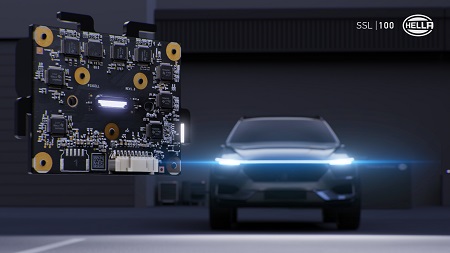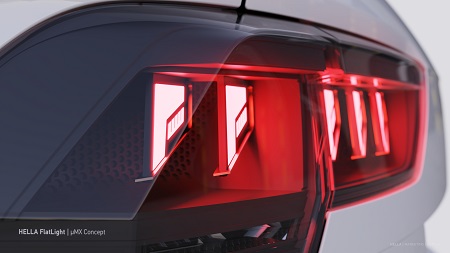As the largest single market in the world, China has been developing into a key driving force in automotive industry in recent years. In order to adapt to the changing market developments and key megatrends such as electrification, software and automated driving, automotive suppliers increasingly need to be supported by efficient local R&D centres.
Since the establishment of the R&D Center in Nanjing in 2011, HELLA, the automotive lighting and electronics expert, keeps on exploring new R&D models and developing lighting and electronics that truly meet the domestic market needs. The product portfolio covers a range of headlamps, rear lamps, interior lighting, body lighting, energy management, driver-assistance systems, and lighting electronics.
International Plastics News for Asia talks to representatives of HELLA Nanjing R&D Center on the developments of automotive lighting given the rapid evolution of automotive technology. On hand to answer the questions are Mr. Chris Kirchenbauer, Head of HELLA Nanjing Technology Center for Lighting; Mr. Harpak Mozaffari Gilani, Head of HELLA Headlamp Product Center in the Asia-Pacific region; Mr. Qin Kai, Head of HELLA Rear Lamp Product Center in the Asia-Pacific region; Ms. Fang Min, Head of HELLA Interior Lighting Product Center in the Asia-Pacific region.

Mr. Chris Kirchenbauer, Head of HELLA Nanjing Technology Center for Lighting (left)
Mr. Harpak Mozaffari Gilani, Head of HELLA Headlamp Product Center in the Asia-Pacific region (right)
How does HELLA respond to the trends of electrification and intelligence?
When talking about China's automobile market, electric vehicles and new energy vehicles cannot be ignored. A lot of opportunities are offered to automotive component suppliers. For instance, there can be a whole new design because electric cars no longer need a traditional engine cooling system. For innovations on the front of the vehicle, HELLA is developing heated radome jointly with JV partner Minth in China and illuminated grille here in Nanjing. HELLA illuminated grille enables the integration of various functions such as position light, daytime running light and direction indicator in the front grille. The radome is not only an important eye-catcher but is also becoming increasingly important in the future with a view to autonomous driving. After all, it protects the sensors, which are essential for autonomous driving, from environmental influences and ensures their functionality. In the Peugeot 308, for example, the radome conceals the automatic cruise control ACC with Stop & Go function including lane departure warning.
Mr. Harpak Mozaffari Gilani: At present, we have carried out mass production of products for some new energy vehicle manufacturers, as well as some on-going discussion on future projects and the application of some new technologies that are still being developed. New energy vehicle providers also bring some innovative concept of intelligence and connectivity, apart from the traditional functions. In this context, HELLA’s digital light can meet customer demand in this area.
In addition, Mr. Harpak highlighted the chip-based light module SSL 100. The LED switch control is fully digitalised with automatic control by ECU. It can be applied to many intelligent interactive scenarios.

Mr. Qin Kai, Head of HELLA Rear Lamp Product Center in the Asia-Pacific region (left)
Ms. Fang Min, Head of HELLA Interior Lighting Product Center in the Asia-Pacific region (right)
What are the key advantages of digitalisation in the development of automotive lighting?
Mr. Qin Kai: From headlamp perspective, the development activities of our headlamp are increasingly geared towards digitalization. The digitalization of headlamp module is becoming finer and finer with the respect to pixel ratios. It offers customers more options for enhanced safety and information functions. In the future, we expect vehicles to be able to communicate with their surroundings via lighting. For rear lighting, apart from meeting the legal requirements and differentiation of the vehicle, we see more animation options, for welcoming scenarios for example. The next level will be the personalization of the animations.
FlatLight, the new combination rear lamp concept from HELLA, is another important lighting innovation. With the FlatLight concept, HELLA is significantly changing the design of future light signatures. This is made possible by a light guide concept based on particularly small micro-optics. These are optical lenses no larger than a grain of salt. Since the indicator, brake and tail light can be implemented in this way in just one optical element, FlatLight technology opens up completely new possibilities for unmistakably staging the rear of the vehicle with characteristic light designs. Another plus point is that FlatLight technology is considerably more efficient and requires around 80 percent less energy than conventional systems.

HELLA SSL 100 lighting module based on chip technology
How does lighting redefine the vehicle interior nowadays?
In addition to headlamps and rear lamps, HELLA sees a huge market for interior lighting. It can be said that interior lighting has become an increasingly important factor to improve the user experience. The combination of personalization and new technologies has opened up a whole new range of possibilities for interior lighting.
Ms. Fang Min: Vehicle is becoming more and more intelligent. Automotive lighting is a very important part of it. HELLA's unique advantage is to combine automotive lighting and electronics technologies to provide innovative solutions for our customers. For example, HELLA's lighting system can be linked with HELLA's smart vehicle entry system. When the car owner approaches the car with HELLA's smart key, the car can actively "sense" the owner's arrival by sensing the smart key, and automatically turn on multi-channel lights such as grille lighting, headlights, interior lights, carpet welcome lights and so on through control components, so as to create a welcoming atmosphere and give car owners more sense of security and a sense of dignity. Through software updates and settings, end users can also adjust the dynamic effects of lighting according to their preferences and have a more personalized experience, bringing individualized experience to end users.
There is no doubt that the vehicle interior will become more and more important in the automated driving. The drivers are free from the traditional driving functions. Driving is no longer drivers’ focus and they can do a lot of other things such as reading emails and search on internet .

FlatLight, the new combination rear lamp concept from HELLA
How does HELLA handle the current semi-conductor challenges in mobility and meet the needs of local customer in R&D?
The bottleneck situation in the field of semiconductors are currently an additional challenge for the entire automotive industry. As an internationally operating automotive supplier, HELLA is also affected by this.
Mr. Qin Kai: Control and memory components are an integral part of many of our products. From one hand, we stabilise our own supply chains as best as possible by finding all the resources we can and then coordinate them globally. Of course, despite all the work, there will be situations where we can't meet 100% of our customers' needs. From the other hand, we are looking at the product design and development, as in the past we basically did not take this factor into account in design. Now we have to plan ahead and consider this matter from the product design.
Mr. Chris Kirchenbauer: In the past 3-4 years, we have been able to complete the system development of the taillight locally. We are well equipped in talents in the R&D center from sales, purchasing, management to product design. For example, now we have more than 100 employees in advanced development, of which only one is a foreigner. We have basically realized the localization of employees. We are fully capable of fulfilling the requirements of design and development.
Imagining the future technology development, HELLA’s vehicle lighting business will continue to focus on the mainstream trends of electrification, design and individualization, thus bring more innovative lighting solutions to the automotive industry.
- This article also appears in the International Plastics News for Asia, April issue. Click here to read the full issue.

 iConnectHub
iConnectHub
 Login/Register
Login/Register Supplier Login
Supplier Login


























